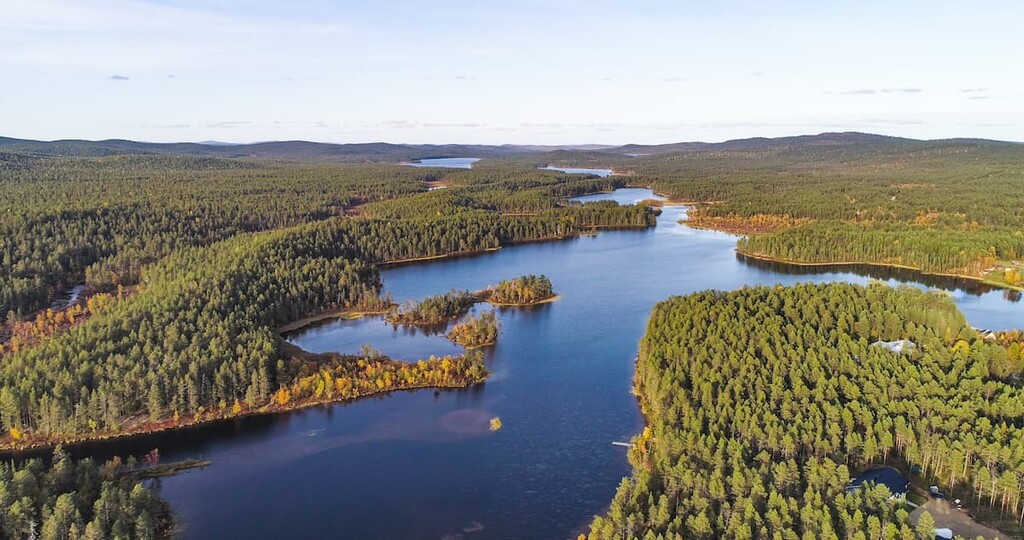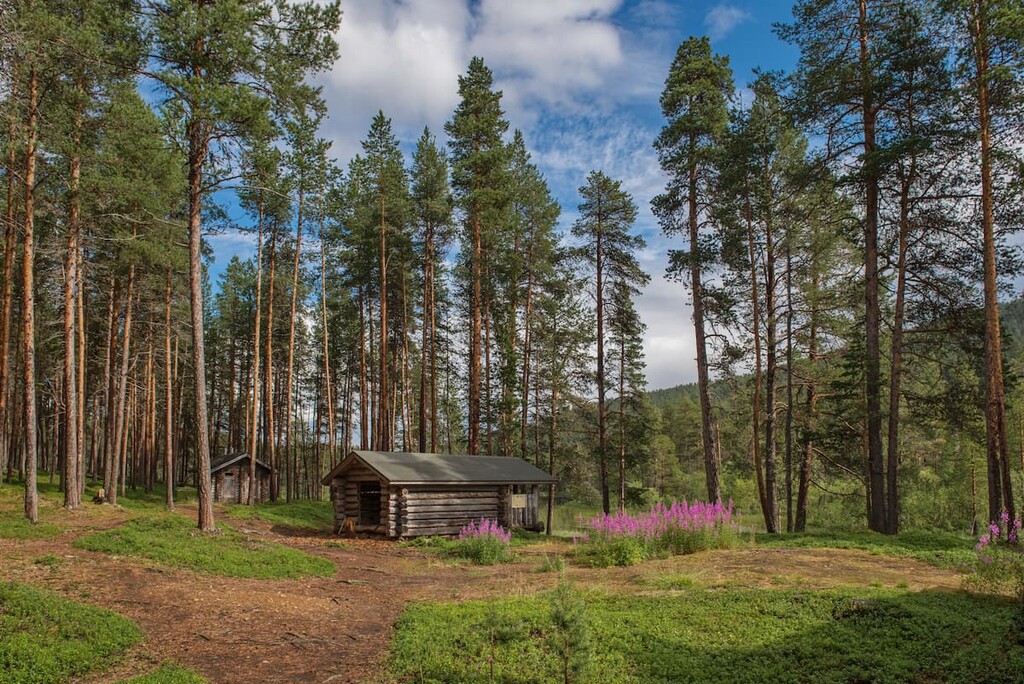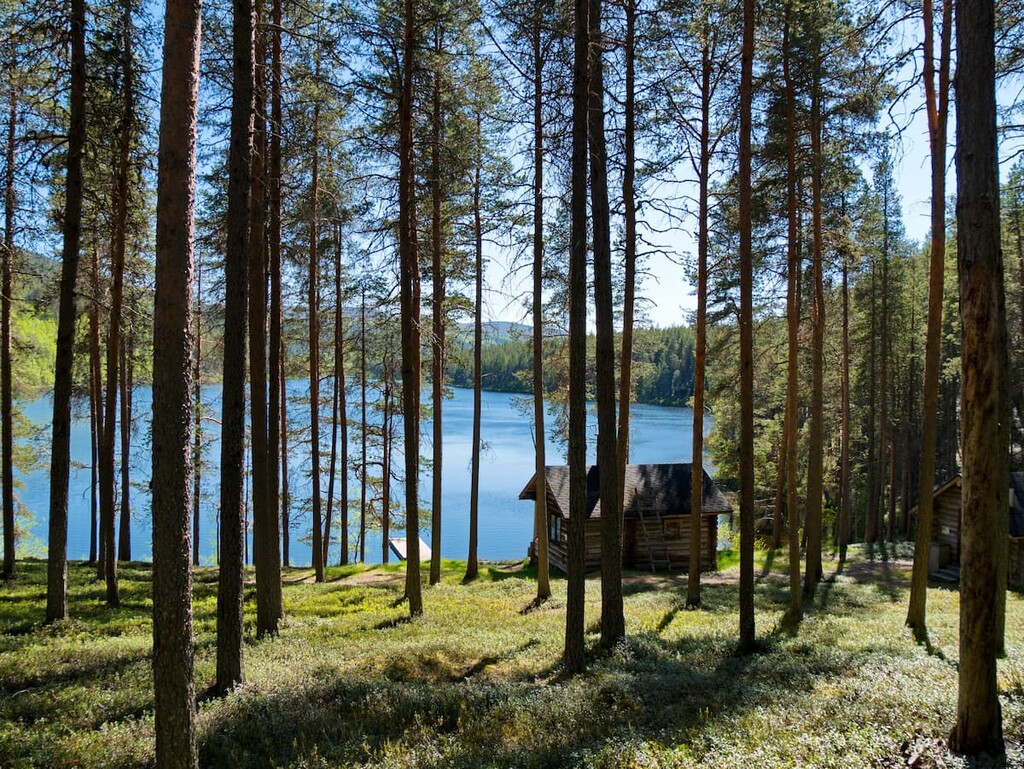Get PeakVisor App
Sign In
Search by GPS coordinates
- Latitude
- ° ' ''
- Longitude
- ° ' ''
- Units of Length

Yes
Cancel
Share ×

Scan the QR code and open PeakVisor on your phone
❤ Wishlist ×
Choose
Delete
Lemmenjoki National Park is one of Finland’s 40 national parks and it is located in the far north of the country in the Lapland region. There are 44 named mountains in Lemmenjoki National Park. The highest and the most prominent mountain is Morgam—Viipus (603 m / 1,978 ft).

Lemmenjoki National Park was founded in 1965. It is located in the communities of Inari and Kittilä in the central part of Lapland province of Finland along the country’s border with Norway. The main feature of the park is its size. It is the largest Finnish national park (2,860 km² / 1,104 mi²), although originally it was smaller as its area has been expanded twice.
The area of the park is quite vast without a clear division into separate parts. However, you can distinguish the central part of the park, where the river flows and where the main trails for tourists are located from the other regions of the park.
That being said, the area in and around the park is difficult to access, and there are no frequent direct transport connections, but it is possible to get here.
From the nearest town, Inari, to the parking lot in a place called Njurkulahti, where the most famous trail of the park Gold Trail begins, it is 46.7 km (29 mi) or 40 minutes by car. You can get to Inari from Helsinki via Rovaniemi, the largest city in Lapland, which has a train station and an airport.
There is also another airport in Ivalo that is some 38 km (23.6 mi) away and 40 minutes by car from Inari. The whole trip from Helsinki to Njurkulahti by car takes about 15 hours (1,130 km / 702 mi).
I have been to Finland 10 times and traveled through it by all possible means of transport. For traveling around the country I highly recommend overland transport, not by air, as Finland is stunningly beautiful and interesting, but you won’t see anything from the airplane.
This is especially true if you are traveling to Lapland, where you can easily meet a moose on the road. By traveling by road, you can also see, not only the north of the country, but also other natural landscapes along the way.

Around the Lemmenjoki, there are two other famous parks: Pallas—Yllästunturi National Park and Urho Kekkonen National Park, as well as several wilderness areas for hiking. Due to the proximity of the Norwegian border, the park also partially borders the Övre Anarjohka National Park in Norway.
Lemmenjoki National Park is named after the beautiful Lemmenjoki River, which flows through its territory. The river itself is the second main feature of the park, after the park’s large size.
The third feature is also related to the river: In the mid-twentieth century, gold was actively mined on this very river, as well as other rivers in the park, leading to a local “gold rush.” We could say that Lapland and, this place in particular, is the Finnish equivalent of the Klondike in the Yukon Territory of Canada or the US state of Alaska, both of which saw major gold rushes. There are many other gold sites in Lapland.
Gold can still be mined today, even by tourists during an excursion or a tour. In fact, there are 25 mining concessions in Lemmenjoki, as well as about 30 gold-digging claims. Because of this, 10,000 local and international tourists visit the park each year to go gold mining.

However, the symbol and logo of the Lemmenjoki, characterizing its nature, is a wolverine. The wolverine is one of the most elusive animals in northern Europe.
Geologically, the entire territory of Scandinavia, including Finland, is located on the Baltic Shield (a segment of the Earth’s crust), which is 1.5 to 3 billion years old. The main rocks here are various kinds of granite, gneisses, shales, quartzites, and other stones—the oldest in Europe.
Therefore, there are many granite rocks and huge boulders in the forests all over the country. In many instances, it seems like something scattered them on purpose. However, these boulders are traces of the glaciers that once covered all of northern Europe.
As I have already mentioned, the main feature of the landscape, which gave the park its name, is the Lemmenjoki River. Its length is more than 70 km (43.4 mi) long. It begins in the park and flows from west to east, where it falls into Inarijärvi Lake—the third largest in Finland.
But there are other rivers in the park including Kietsimäjoki, Vaskojoki, Repojoki, Ivalojoki, among others. The main lake of the park, Lemmikäsjärvi Lake, is located in the center of the park. From here the Lemmenjoki River starts.

Have you just noticed that the river's names all end the same way—“joki”? It is the same with the lakes—“jarvi”, islands—“saari”. This is not a coincidence and, in fact, by recognizing that fact, you are learning one of the most difficult languages in the world right now!
The Lemmenjoki National Park's rivers are a sign that it is mostly a flat area. It is mainly covered by swamps, especially in the southern part of the park. In contrast, the northernmost part of the park is home to permafrost, which is ground that does not melt, even in summer. As a result, this area cannot support abundant vegetation.
The territory of the Finnish part of Lapland is vast area of land with small mountains, or hills, or fells, as they are called, up to 1,000 m (3,280 ft). Within the territory of the park, there are also 44 small mountains—“oaivi” in Finnish.
The fells are the remnants of very ancient mountains, the Karelides, that existed in Finland some 2 to 3 billion years ago. During this time, the range extended to the Finnish part of the Karelia region, which is divided into North Karelia and South Karelia in the southeastern part of the country.
Nowadays, we can only see the bases of these mountains. But, imagine what they looked like when they reached the height of the Alps, where the highest mountain is Mont Blanc (4,807 m / 15,774 ft)!

Morgam—Viipus (603 m / 1,978 ft) is not only the highest point in the national park, but also in the entire municipality of Inari. Despite the low altitude compared to the mountains in the Alps or Pyrenees, for example, it is a high mountain for Finland. In good clear weather, it offers a view of many kilometers to all four sides of the world.
The other highest peaks in the park are:
The park has 34 more peaks of about the same height up to 500 to 600 m (1640 to1970 ft), many of which you can easily climb.
Up to 500 to 600 m (1640 to1970 ft), there are old-growth pine forests in the park. This is the name given to old broad and very tall trees many hundreds of years old, which are now difficult to find in Finland and in the world. However, pines are often mixed with spruces and birch in Finland.
In the swamps of the park, there are such rare northern plants as Arctic arnica, marsh saxifrage, Hudson Bay sedge, northern moonwort, nahanni oak fern, lesser meadow-rue, and others. Rare moss species also thrive on these rocks here.

Remember that you can pick berries and mushrooms everywhere in the park—two main features of a Finnish nature experience.
Walking along the paths of the park, you can meet its symbol wolverine. Or rather, you will be very lucky if you see them. This amazing animal lives all over the Northern Hemisphere, but it tries to avoid contact with humans. The park is also home to wolves, but you should hardly prepare for an encounter with them, as they mean no harm.
The whole territory of the Lemmenjoki National Park is a nesting place for many birds, which you can see with your own eyes: brambling, grey-headed chickadee, Eurasian three-toed woodpecker, birds of prey, white-throated dipper, Eurasian teal, long-tailed duck, and others.
Partridges are very common, too. I saw them several times, though they tend to fly out of blueberry bushes or from the snow in winter and immediately disappear into the next bush or snowdrift.
The rivers of the park are home to dozens of salmonid fish, including salmon, trout, whitefish, grayling. The fish also includes northern pike, perch, burbot, three-spined stickleback in the lakes and ponds. So, Lemmenjoki is a paradise for anglers.

The park has 60 km (37.2 mi) of marked hiking trails of varying lengths, from half-day walks to multi-day backpacking through the wilderness areas. Up next, I will tell you about the three main trails:
The Lemmenjoki Nature Trail is a small trail at the starting point of the national park that winds through hilly old-growth pine forest with views of the Lemmenjoki River valley.
The trail is suitable for those who only want a glimpse of the park as part of a larger trip through Finland with many locations. Usually, people who travel here go also to Norway, or Russia. Nevertheless, if you like it here, the trail has a place to pitch a tent and make a fire.
In addition to the river and forest, the main attraction on the trail is the old homestead of the famous Sámi family Kaapin Jouni.

The park's main and most famous trail, the Lemmenjoki Gold Trail (Kultareitti Trail), goes along former and present gold mining sites on the Lemmenjoki River. Information boards along the entire trail tell you about the history and geology of gold and mining methods.
On the trail you will also test on your own feet on the steepness of Hengenahdistusmäki Fell (I hope you were able to pronounce it), which is locally called “Short-of-Breath Hill.” While here, visit the place where gold was first found on the Morgamoja River; stay in one or two of the forest huts for the night; and just take a great walk through ancient pine forests and open terrain with panoramic views.
The trail looks easy to hike, but will eventually require you to be physically fit because of the many climbs and descents that continue after the first hill—the trail isn't flat. My advice is to pack your backpack wisely, so you don’t have anything extra in it.

The Joenkielinen Loop is a simple day hike to the Joenkielinen Fell (534 m / 1,751 ft), the closest to the starting point of all excursions in the park. From the top of the fell, you can see the Lemmenjoki River valley, as well as the neighboring Hammastunturi wilderness area.
If you will spend the night in the park, I recommend walking the route just after sunrise or closer to sunset to see how the river glistens in the morning or evening sunlight.
But in general, remember that in summer Lapland is the land of the midnight sun—the sun practically does not set below the horizon for two months in a row from about the 20th of May to the end of July. That’s why this and other trails can be hiked even at night!

In addition to hiking and backpacking, Lemmenjoki National Park also offers other activities like boating, fishing, cycling and mountain biking, canoeing and rowing, bird and wildlife watching, and picking berries and mushrooms. You can also enjoy the local saunas.
In the winter, there is also a marked skiing trail on the ice of the Lemmenjoki River, as well as plenty of opportunity for off-piste adventures.
There is no visitor center within the park. However, you can get more information about the routes, buy paper maps and souvenirs, book rental wilderness huts, and more at the “Siida” Museum, which is located in Inari. This is the main museum of Lapland and the local Sami culture. Until April 2020, it is under restoration, but the museum is open for visitors.
The Sami Museum and Northern Lapland Nature Centre “Siida”
Inarintie 46, 99870, Inari, Lapland, Finland
+358 40 168 9668
From June 1 to September 30, 2021, open daily from 9 am to 5 pm
Tickets:
tourist.info@inari.fi
You can also get more information about Lemmejoki at the official Finnish national parks website.

In Finland’s national parks, there are some simple rules of responsible travel that are important to know and follow:
You can:
You can also do these activities, with some limitations:

You can’t:
When hiking in Finland’s national parks, you can stay overnight in one of several basic types of temporary accommodation. In total, there are about a dozen of them. They differ in terms of conditions and rules, quantity, and cost.
There are 11 open wilderness huts with free beds for 1 to 2 nights. Three of them are located on the Gold Trail, and eight others in the different parts of the park. On the trail, there are also two rental huts for €30 to €50 euros for 12 or 24 hours, respectively. Additionally, of course, you can pitch a tent in the park’s special areas.
You can find out more about overnight stays in the parks in the “Services” section of each park’s page on the official website of the National Parks of Finland.
Local tourism companies also rent holiday cottages in the Njurkulahti area. There are also camping grounds and services for travelers with caravans in Lemmenjoki, Menesjärvi, and Inari. However, the nearest hotels are located in Menesjärvi and Inari.

Inari is the main town of the Sámi, the native people of Lapland, but in the Northern Sami language it is called Anár. The town was founded in 1876 and it has 6,787 inhabitants (2010) in an area of 17.3 sq. km (10.7 sq. mi).
Although the town itself is small in terms of its population, it is the largest community in Finland by total land area. The municipality also includes Angeli, Ivalo, Näätämö, Nellim, Saariselkä and other towns. But vast parts of the municipality are wilderness areas including Hammastunturi, Muotkatunturi, Paistunturi, Kaldoaivi, Vätsäri, and Tsarmitunturi.
The Sámi are a group of Indigenous people of Northern Europe who traditionally live in a region known as Lapland. However, it is important to note that while the region of Lapland is an official region in Finland, the traditional territory of the Sámi extends well outside the country’s borders. Indeed, the Sámi have long lived throughout a region that stretches from Norway through Sweden to Russia—four independent countries.

Many Sámi are reindeer herders. They have their own language and culture—including their traditional red and blue national dress. The Sámi keep the legends and tales of their ancestors and they have their own parliament in Norway, Sweden, Russia and Finland, though the parliament in Russia is not federally recognized.
The main cultural attractions in Inari are the building of the Sami Parliament of Finland; the Sami cultural center, “Sajos;” and the Northern Lapland Nature Centre,“Siida.” There are also a number of churches, including the snow-white Saamelaiskirkko church, which is surrounded by pines; the Saamelaiskirkko church; and the more urban Ivalon church.
The main natural attraction of Inari is Finland’s third-largest lake, Inarijärvi, which is up to 92 m (301 ft) deep. You can learn more about the attractions in the region by checking out the Inari tourism website.

Explore Lemmenjoki National Park with the PeakVisor 3D Map and identify its summits.








